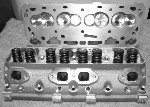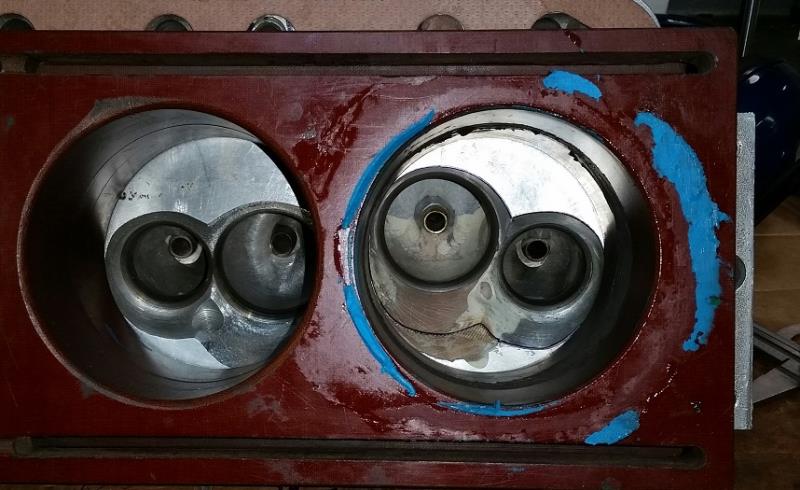|
Author
|
Message
|
|
Canadian Hot Rodder
|
|
|
Group: Forum Members
Last Active: 7 Years Ago
Posts: 691,
Visits: 1.3K
|
I agree with John, and no matter what modifications were done, in all it brings the long overdue publicity to the Y-Block! It shows you can go extreme like Kaase, or you can keep pretty close to stock form and make great horsepower /torque like Ted & Royce. So kudos to all, maybe now, nay sayers like Vic Edelbrock Jr. will eat their words and give the little Y the respect it deserves! I know personally, I have opened the eyes of a dye hard LS scrub lover, with both my basic street motor and showing him the articles of what Ted, John, Kaase, Royce, Jerry, etc. Have done! Congrats to all!!!
I love the smell of burning rubber in the morning!
|
|
|
|
|
glrbird
|
|
|
Group: Forum Members
Last Active: 8 Months Ago
Posts: 616,
Visits: 7.1K
|
Jon Kasse is a racing engine builder, innovation and thinking outside the box is the only way to make gains on performance. He uses that thinking when building a EMC engine. If no one wanted better performance from the y-block, Mr. Mummert would not be making heads and manifolds.
Gary Ryan San Antonio.TX.
|
|
|
|
|
Ted
|
|
|
Group: Administrators
Last Active: Last Month
Posts: 7.5K,
Visits: 205.8K
|
Thanks to all for the Kudos and ditto on John Mummert’s comments. While it’s been generally accepted in the Y-Block community that the stacked intake ports are what makes a Ford Y-Block unique, Jon Kaase’s redesign using the LYB (Lincoln Y-Block) side by side port design does fit within the letter of the rules for this competition. Within that same line of reasoning, it has been widely known that the SBF heads would fit on a Y with some work but it simply wasn’t going to happen here in the States for the Y competitions simply due to doing away with the stacked ports. On the other hand, the Argentina Y-Block did go with the SBF port orientation and firing order which was used for a couple of decades after the Y was discontinued here in the States. To Jon Kaase’s credit, he did start with a pair of Y castings and simply cut the stacked ports out and replaced them with side by side ports in order to have the ports positioned where the valves could have a straight shot through the intake runners. That was an incredible amount of welding in which to make that happen. The remainder of Jon’s engine was just as innovative so there was definitely a lot of work performed in just a short period of time. Jon’s engine was built specifically for the 3000 to 6000 rpm band and the final point score was very good as a result. With all that being said, The Eaton Balancing entry did rank third in the points scoring. With Jon’s engine being ~200 points ahead of mine (2586 vs 2389), that was going to be a bunch to compensate for with what I had to work with. I ended up with a 362 inch engine simply due to not having enough lead time for a longer arm crankshaft. On the other hand, the School of Automotive Machinists Poly entry was second at 2454 points which was within the range that my entry might be capable of exceeding with just a few changes. Some more testing in the next couple of weeks on the current combination will prove or disprove that. As Royce has already mentioned, the UNOH dynos were stingy with their numbers but this applied for all competitors so it was a level playing field. I had repeatedly posted a 574HP value at 6000 rpms on my own dyno but could only achieve a 542HP value on the UNOH dyno at that same 6000 rpms. The other competitors also noted a similar drop in numbers from their own dyno testing. The HP numbers for my entry at 6800 rpm though were very stout and that’s with the EMC tuneup and not a tuneup conducive for even higher topend HP numbers. Part of that was the result of not running the camshaft originally designed for this combination as I did have some problems with the original camshaft and had to go with one that was sitting on the shelf. I am still happy with the performance of my own engine as it’s still very conventional in nature. And this years’ entry can be repurposed very easily to another application. I am already thinking of a combination for next year’s EMC competition as I do have some more ideas on getting that performance level up much higher. As usual this year presented me with more new learnings and I’ll apply some of those to the new combination. Congratulations to Royce on his 4th place finish with his Lincoln Y-Block entry as it was a very repectable showing. The 5th place finish was a Packard V8 which also ran quite well. The sixth engine on the list was another Poly motor that did not run due to an oiling problem in its topend. Much thanks to those of you that contributed to this year’s entry. Those contributions were put to good use.
  Lorena, Texas (South of Waco) Lorena, Texas (South of Waco)
|
|
|
|
|
John Mummert
|
|
|
Group: Forum Members
Last Active: Last Month
Posts: 915,
Visits: 7.5K
|
I did find it interesting to see what Kaase has done with his engine as he was pretty tight lipped. I know he says in his video that He and SAM "essentially" had some info sharing, as employees and students talk. I however didn't know just how far he was taking it. I think many have found it fascinating to see Kaase's engine apart and on display. Hearing more about the other Y blocks in the competition would give us more appreciation for their accomplishments. Building engines for these competitions is a ton of work and expense. A lot of learning, frustration , and happiness comes out of these projects. Knowing that Ted and Royce went through a lot of effort with their engines I think it would be very interesting to hear some more in depth stories. Teds score shows large gains over his 2010 entry. From my calculations Ted achieved more hp/cu in than any other engine in the class. That's saying something. As has been pointed out Ted and Royces engine could be duplicated and owned by anyone. Kaase's engine as interesting as it was, realistically could not, in any reasonable time and budget. A lot of credit needs to go to the guys that put themselves in the arena, and compete. Geoff Mummert.
http://ford-y-block.com 20 miles east of San Diego, 20 miles north of Mexico 
|
|
|
|
|
speedpro56
|
|
|
Group: Forum Members
Last Active: Last Year
Posts: 1.3K,
Visits: 9.2K
|
Kaase's engine was really impressive and Mummert is right, that's the way things are made to be on top for which he went for, but Ted and Royce were just as impressive with their builds for which those parts are available and you can set their engines as is in a hot rod and kick some serious hiney! All three of those guys did a really great job for the yblocks (Ford and Lincoln).
-Gary Burnette-
|
|
|
|
|
John Mummert
|
|
|
Group: Forum Members
Last Active: Last Month
Posts: 915,
Visits: 7.5K
|
Here is a fun pic of Mummert head #001, its life has been dedicated to R&D. This design started coming to life the day that people started talking about building a big bore block. The plan was to have a valve location that would be very good in original blocks, and have the room to go 2.08- 2.125 in 4.00-4.125 bore blocks.. We just got our new angle milled CNC ported race head with standard port design out to Ted before the EMC competition. It seems to have some real promise.  http://ford-y-block.com
http://ford-y-block.com 20 miles east of San Diego, 20 miles north of Mexico 
|
|
|
|
|
pegleg
|
|
|
Group: Forum Members
Last Active: 3 Years Ago
Posts: 3.0K,
Visits: 8.7K
|
Rotated Valves?? It's a Cleveland? You got some Splainin' To do Lucy!
Frank/RebopBristol, In ( by Elkhart) 
|
|
|
|
|
John Mummert
|
|
|
Group: Forum Members
Last Active: Last Month
Posts: 915,
Visits: 7.5K
|
We've tried lots of experiments with old #001. Side by side ports were tried some time ago and showed promise on the flow bench. Looked a little too scrubbie for us to think it would be well received. We've looked at some other configurations that I wouldn't want to mention. Still considering some other options but we feel we are getting near the limits of the OE stacked port layout. There are limitations build into that configuration that limit the potential. The heads we sent Ted are the best to date we have come up with. The numbers Ted achieved are remarkable with the cam not being of his choosing and having to use a dual plane intake manifold. The biggest limiting factor of the original port layout is that the lower port starts out near the deck surface and needs to rise to attain a reasonable short turn height. This is critical to get the air/fuel to aim down the cylinder and not centrifuge around the chamber. Unfortunately, the lower port is under the upper port and can't rise very much until it clears the upper port. At the same time the upper port needs to start turning toward the valve seat. Again, it can't because the lower port is under it. The interaction of the two ports in physical space is the limiting factor of the design. We have considered moving the valves closer to the center of the bore, which is the best place for the intake valve. However, moving the valves closer to the intake manifold shortens the distance the ports have when they are not interacting with each other even more. It appears that the next step has to be a layout without stacked ports if the power levels are to exceed 600hp.Very few will want to exceed that number, but somebody will, so the quest continues.
http://ford-y-block.com 20 miles east of San Diego, 20 miles north of Mexico 
|
|
|
|
|
'60 Fairlane
|
|
|
Group: Forum Members
Last Active: 9 Years Ago
Posts: 71,
Visits: 539
|
Why does it sound better when Mr, Mummert talks about rearranging the ports on the Y-Block? Maybe it's because we know he is in it for the long haul.
Thank you for all you've done for this obsolete little mill and all of us who love it!
-Dave
|
|
|
|
|
aussiebill
|
|
|
Group: Forum Members
Last Active: 5 Years Ago
Posts: 1.8K,
Visits: 11.4K
|
I think standing back and looking at Teds participation in EMS with what is basically original style engine running single 4 bbl carb compared to jon kaases highly modified 2 x 4 engine, ted finished ahead in my book.
 AussieBill YYYY Forever Y Block YYYY AussieBill YYYY Forever Y Block YYYY Down Under, Australia
|
|
|
|